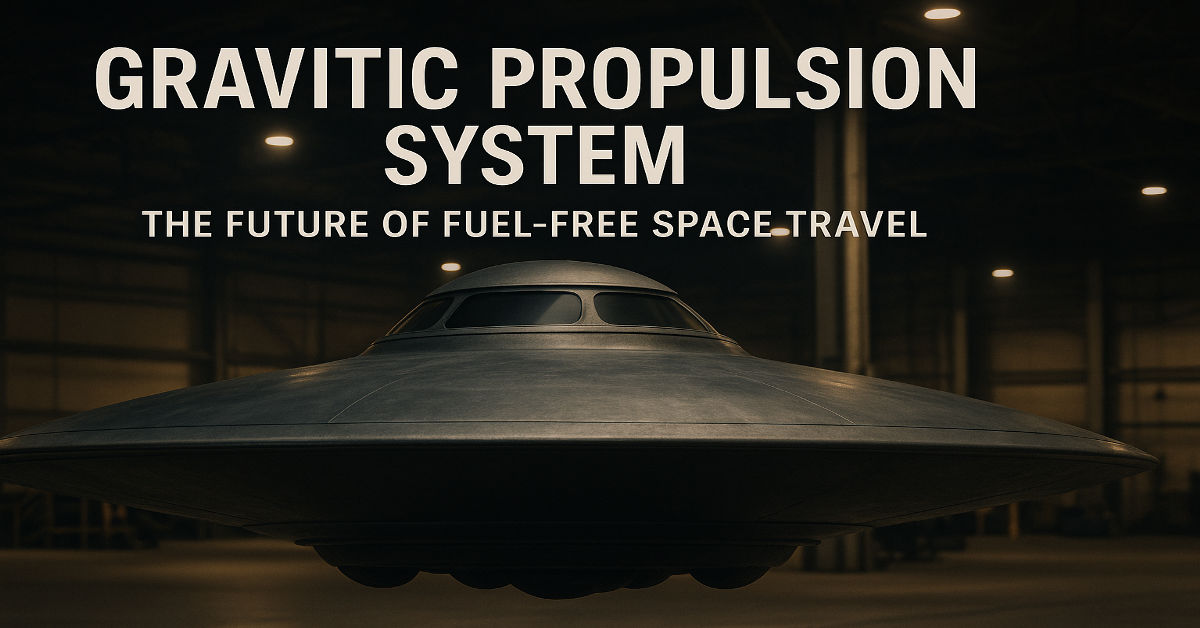Space travel has always been limited by the immense cost and complexity of moving massive objects across great distances. Traditional propulsion systems rely heavily on chemical reactions and fuel combustion, which are neither efficient nor sustainable for long-term exploration. Enter the gravitic propulsion system—a concept that uses gravity itself as the engine.
This article explores the fascinating history, theory, and technological breakthroughs that bring gravitic propulsion closer to reality.
What Is a Gravitic Propulsion System?
A gravitic propulsion system is a hypothetical or experimental technology that manipulates gravitational fields to create thrust. Instead of burning fuel, these systems harness gravitational or electrogravitic forces, potentially allowing vehicles to move silently, efficiently, and without exhaust.
Unlike rockets that expel mass to generate forward motion, gravitic systems manipulate the spacetime around the craft.
The Origins: T. Townsend Brown and the Biefeld-Brown Effect
In the 1920s, physicist T. Townsend Brown began experimenting with high-voltage capacitors. His research revealed that when a strong electric field was applied across asymmetrical capacitors, a measurable force moved the device in the direction of the positive electrode.
This became known as the Biefeld-Brown effect. While controversial, Brown believed he had uncovered the basis for gravitational manipulation, launching a lifelong pursuit of gravitic propulsion.
How Gravitic Propulsion Differs from Traditional Engines
Traditional engines:
- Rely on combustion of fuel
- Expel gas to generate force (Newton’s Third Law)
- Require large amounts of stored energy
Gravitic propulsion:
- Generates motion without expelling mass
- Uses high-voltage fields or gravity distortion
- Could enable silent, fuel-free spaceflight
Key Breakthroughs in Gravitic Propulsion Technology
1. Electrogravitics
Research into using electric fields to affect gravitational mass gained traction in the 1950s and again in the early 2000s.
2. Podkletnov Experiments
In the 1990s, Russian scientist Eugene Podkletnov claimed to have created anti-gravity effects using rotating superconductors.
3. NASA’s Breakthrough Propulsion Physics Program
While not confirming gravitic propulsion, this NASA program explored alternative concepts like warp drives and space-time manipulation.
4. U.S. Navy Patents
Recently, a series of patents were filed by Salvatore Pais on behalf of the U.S. Navy, describing gravity wave generators and inertial mass reduction devices.
Table: Historical vs Emerging Propulsion Systems
| Propulsion Type | Fuel Dependency | Exhaust Emission | Travel Range | Stage of Development |
| Chemical Rocket | High | Yes | Limited | Mature |
| Ion Thruster | Medium | Minimal | Moderate | In use |
| Nuclear Thermal | Medium-High | Yes | Moderate-Far | Under testing |
| Gravitic Propulsion System | None | None | Theoretical-Far | Experimental/Speculative |
Modern Research and Aerospace Developments
Several aerospace organizations and independent labs are revisiting Brown’s legacy through modern tools:
- Lockheed Martin: Rumored to research electrogravitics under black-budget programs
- NASA and DARPA: Investigating inertial manipulation
- The AATIP Program: Former U.S. Defense Department initiative that included sightings of craft with unusual flight behavior, possibly related to gravitic propulsion
While none have officially confirmed operational gravitic craft, research papers and patents suggest interest is real.
Theoretical Foundations: Gravity as a Propulsive Force
Gravitic propulsion is based on manipulating the fundamental properties of gravity. The core ideas include:
- General Relativity: Space and time can be bent or manipulated by mass and energy
- Quantum Field Theories: Hypothesize particles like gravitons that mediate gravity
- Zero-Point Energy: The vacuum of space might be harnessed for energy and thrust
These ideas remain mostly theoretical but provide the blueprint for future technology.
Controversies and Skepticism in Mainstream Science
Despite compelling anecdotes and patents, gravitic propulsion remains controversial:
- Lack of Peer-Reviewed Evidence
- Replicability Issues with past experiments
- Misinterpretation of Electrical Phenomena
Many scientists argue that observed thrust could be ionic wind or electromagnetic artifacts rather than true gravitational manipulation.
However, this skepticism drives more rigorous experimentation.
Potential Applications in Space and Earth
If perfected, gravitic propulsion could revolutionize multiple fields:
- Interplanetary Travel: Reduce travel time from months to days
- Satellite Maneuvering: Silent repositioning without propellant
- Deep Space Exploration: Enable missions beyond our solar system
- Earth Transport: Future hovercrafts and air vehicles without engines
Limitations and Engineering Challenges
While promising, this technology faces significant hurdles:
- Power Requirements: Extremely high voltages and energy densities
- Material Constraints: Superconductors and exotic materials may be required
- Control Systems: Difficulties in stabilizing and directing thrust
- Regulatory and Safety Barriers: Unknown effects on electronics and environment
These barriers mean widespread adoption is still decades away.
Conclusion
Gravitic propulsion systems may sound like something out of a sci-fi movie, but scientific curiosity and technological innovation are bringing us closer to making them real. From the pioneering work of T. Townsend Brown to cutting-edge aerospace patents, the road to fuel-free space travel is being paved slowly—but steadily.
If future generations unlock the secrets of gravity-based travel, we could reach the stars faster, cleaner, and more efficiently than ever imagined.
Stay informed. Share this article and explore the future of propulsion with an open mind.
Frequently Asked Questions (FAQ)
Q1: Is gravitic propulsion real or science fiction?
It is currently experimental and largely theoretical, but grounded in real physics concepts.
Q2: What is the Biefeld-Brown effect?
It refers to an observed thrust produced when a high-voltage capacitor is used, possibly due to electrogravitic forces.
Q3: Are any governments researching gravitic propulsion?
Yes. Declassified documents, patents, and programs suggest interest from the U.S. military and other aerospace agencies.
Q4: Can we build a working gravitic propulsion system today?
Not yet. The necessary control, materials, and energy systems are still being developed or understood.
Q5: What are the biggest challenges in gravitic propulsion development? Generating enough thrust, verifying repeatable effects, and scaling the system for real-world use.

